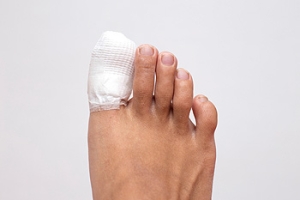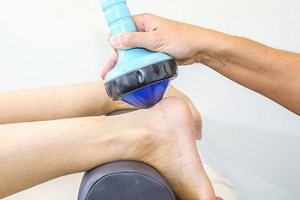
Causes of a Broken Toe
 If you have experienced breaking your toe, which is also referred to as a fractured toe, you may be aware of the severe pain that is often associated with it. There may be several reasons why this type of injury may occur. These may include dropping a heavy object on your toe, stubbing it against a piece of furniture, or being involved in an accident in which your feet are affected. There are noticeable symptoms that are indicative of a broken toe, including bruising, swelling, the inability to walk on it, accompanied by pain and discomfort. Treatment options may include keeping the foot raised, which may aid in reducing any swelling, taping the injured toe to the toe next to it to promote stability, in addition to wearing shoes that have adequate room for the toe. If you feel you have broken your toe, it’s advised to counsel with a podiatrist so the best course of treatment can begin.
If you have experienced breaking your toe, which is also referred to as a fractured toe, you may be aware of the severe pain that is often associated with it. There may be several reasons why this type of injury may occur. These may include dropping a heavy object on your toe, stubbing it against a piece of furniture, or being involved in an accident in which your feet are affected. There are noticeable symptoms that are indicative of a broken toe, including bruising, swelling, the inability to walk on it, accompanied by pain and discomfort. Treatment options may include keeping the foot raised, which may aid in reducing any swelling, taping the injured toe to the toe next to it to promote stability, in addition to wearing shoes that have adequate room for the toe. If you feel you have broken your toe, it’s advised to counsel with a podiatrist so the best course of treatment can begin.
A broken toe can be very painful and lead to complications if not properly fixed. If you have any concerns about your feet, contact Dr. Lee R. Stein from Lake Shore Foot & Ankle, PC. Our doctor will treat your foot and ankle needs.
What to Know About a Broken Toe
Although most people try to avoid foot trauma such as banging, stubbing, or dropping heavy objects on their feet, the unfortunate fact is that it is a common occurrence. Given the fact that toes are positioned in front of the feet, they typically sustain the brunt of such trauma. When trauma occurs to a toe, the result can be a painful break (fracture).
Symptoms of a Broken Toe
- Throbbing pain
- Swelling
- Bruising on the skin and toenail
- The inability to move the toe
- Toe appears crooked or disfigured
- Tingling or numbness in the toe
Generally, it is best to stay off of the injured toe with the affected foot elevated.
Severe toe fractures may be treated with a splint, cast, and in some cases, minor surgery. Due to its position and the pressure it endures with daily activity, future complications can occur if the big toe is not properly treated.
If you have any questions please feel free to contact one of our offices located in Chicago, Highland Park, and Uptown, IL . We offer the newest diagnostic and treatment technologies for all your foot and ankle needs.
What to Know About a Broken Toe
Trauma to the foot, especially the toes, can occur in many ways. Banging them, stubbing them, or dropping something on them are a few different ways this trauma can occur. Given the fact that toes are positioned in front of the feet, they typically sustain the brunt of such trauma. When trauma occurs to a toe, the result can be a painful break or fracture. Another type of trauma that can break a toe is repeated activity that places stress on the toe for prolonged periods of time.
Broken toes can be categorized as either minor or severe fractures. Symptoms of minor toe fractures include throbbing pain, swelling, bruising on the skin and toenail, and the inability to move the toe with ease. Severe toe fractures require medical attention and are indicated when the broken toe appears crooked or disfigured, when there is tingling or numbness in the toe, or when there is an open, bleeding wound present on the toe.
Generally, a minor toe break will heal without long-term complications. However, it is important to discontinue activities that put pressure on the toe. It is best to stay off of the injured toe and immediately get a splint or cast to prevent any more additional movement of the toe bones. You can also immobilize your toe by placing a small cotton ball between the injured toe and the toe beside it. Then, tape the two toes together with medical tape. Swelling can be alleviated by placing an ice pack on the broken toe directly as well as elevating your feet above your head.
Severe toe fractures may be treated with a splint, cast, and in some cases, minor surgery, especially when the big toe has been broken. Due to its position and the pressure the big toe endures with daily activity, future complications can occur if it is not properly treated. Pain associated with minor toe fractures can be managed with over-the-counter pain medications. Prescription pain killers may be necessary for severe toe fractures.
The healing time for a broken toe is approximately four to six weeks. In severe cases where the toe becomes infected or requires surgery, healing time can take up to eight weeks or more. While complications associated with a broken toe are immediately apparent, it is important to note that there are rare cases when additional complications, such as osteoarthritis, can develop over time. You should immediately speak with your podiatrist if you think you have broken your toe due to trauma. They will be able to diagnose the injury and recommend the appropriate treatment options.
There Are Two Forms of Shock Wave Therapy
 A form of therapy that is referred to as extracorporeal shock wave therapy, which is also known as ESWT, may possibly aid in helping patients with pain associated with tendons. People who experience plantar fasciitis may benefit from this type of treatment. It may promote healing and this may reduce some of the pain and discomfort that is typically associated with this condition. There are generally two forms of this type of treatment. One is referred to as a high-energy shock wave treatment, often including the therapy to be performed in one session. Some patients experience severe pain if this procedure is chosen, and may be administered anesthesia. Low-energy shock wave treatments may consist of being given in three or more sessions and typically causes mild or no pain. If you are experiencing tendon ailments, please speak with a podiatrist if you would like information about shock wave therapy.
A form of therapy that is referred to as extracorporeal shock wave therapy, which is also known as ESWT, may possibly aid in helping patients with pain associated with tendons. People who experience plantar fasciitis may benefit from this type of treatment. It may promote healing and this may reduce some of the pain and discomfort that is typically associated with this condition. There are generally two forms of this type of treatment. One is referred to as a high-energy shock wave treatment, often including the therapy to be performed in one session. Some patients experience severe pain if this procedure is chosen, and may be administered anesthesia. Low-energy shock wave treatments may consist of being given in three or more sessions and typically causes mild or no pain. If you are experiencing tendon ailments, please speak with a podiatrist if you would like information about shock wave therapy.
Shockwave therapy is a treatment commonly used to treat various injuries and conditions, particularly plantar fasciitis in the feet. To learn more, consult with Dr. Lee R. Stein from Lake Shore Foot & Ankle, PC. Our doctor can provide the care you need to keep you pain-free and on your feet.
Shockwave Therapy
Shockwave therapy is a new treatment option designed to treat bone conditions such as tennis elbow, shoulder pain, and others. Shockwave therapy uses high intensity sound waves that are directed to the affected tissues of the body with pinpoint accuracy. The effects are very beneficial, leading to a production of collagen fibers, eliminating inflammation.
Who Benefits from Shockwave?
Shockwave is recommended for patients suffering from heel pain and associated problems. Heel pain is a common condition which can be caused by obesity, overexertion, and spending a substantial amount of time on hard floors with your feet exposed and unsupported.
Fast and Easy
The therapy is actually a simple process that can leave patients feeling better the very next day. Shockwave therapy is not as dramatic as it sounds. It enables more blood flow to effected areas, addressing the source of the problem and allowing treatment to last for a long time.
Treatment & Recovery Time
Shockwave treatment will enable your feet to recover quickly. This is especially important since surgery is not required. It is cost effective and does not require the use of anesthesia. This treatment is a better option to surgery, since it is proven safe.
If you have any questions, please feel free to contact one of our offices located in Chicago, Highland Park, and Uptown, IL . We offer the newest diagnostic and treatment technologies for all your foot and ankle needs.
Shockwave Therapy
Extracorporeal Shockwave Therapy (ESWT) is an alternative treatment method that is used for bone and soft tissue disorders in the foot and ankle. EWST is a noninvasive option for pain relief and it was originally created to help dissolve kidney stones. This therapy works by focusing impulses to target the area in pain. This method has been proven to show a reduction in the amount of nerve fibers that transmit painful impulses, which leads to a reduction in pain. Shockwave therapy can also expedite the tissue which would, in turn, increase the amount of new blood vessels that are formed.
Conditions that can be treated with shockwave therapy include Achilles pain and heel pain. People with plantar fasciitis may opt for this therapy and the results are usually great after 18 months. Additionally, this method can also be used to treat fractures that have failed to heal correctly. Anesthesia is not required to perform this treatment. It usually is not painful, but it can be uncomfortable.
The duration of treatment sessions usually lasts 5-15 minutes each. This procedure is safe since there is no risk of infection from wound complications, if you are looking to try shockwave therapy to heal plantar fasciitis, it may take 3-4 sessions to start working. After treatment, patients typically notice a dull pain in the area which was treated. However, this pain rarely lasts more than 24 hours.
Nevertheless, there are pros and cons that come along with Shockwave Therapy. The most obvious pro is that this treatment is noninvasive, meaning surgery will not be required. Another upside is that there have been very little complications that have been found with this procedure. On the other hand, those who opt for surgery are at risk for continued pain, wound problems, and infections. The biggest con for ESWT is that it is very expensive; it typically costs around $1,000 before insurance. Another con is that the effectiveness of the treatment is questionable. Usually, if this treatment is helpful, the difference is small.
If you are curious about Shockwave Therapy, you should talk to your podiatrist to see if this treatment method is right for you. At times, patients will find that there are other treatment options that are more efficient for their individual cases.
Wounds That Don't Heal Need to Be Checked
Three Basic Foot Shapes
 When a child is born, the feet are often comprised of flexible and soft cartilage, and the bones will eventually harden as the teenage years approach. Research has shown there are three basic foot shapes, and this will typically become evident when the child reaches two years old. A square foot shape consists of all the toes being the same length, while a rounded shape occurs when the big toe is shorter than the second or third toe. Additionally, if the big toe is the longest of all the toes, this is known as a tapered shape. Your child will benefit by spending the majority of the day without shoes on, and this will make it easier to strengthen and exercise the feet. Shoes will become a necessity when outdoor walking begins and this will enable the feet to adapt to different surfaces. When buying a first pair of shoes for your child, it may be beneficial to choose shoes that are constructed with flexible, non-slip soles, in addition to being lightweight. Please consult with a podiatrist for additional information on how to properly care for your child’s feet.
When a child is born, the feet are often comprised of flexible and soft cartilage, and the bones will eventually harden as the teenage years approach. Research has shown there are three basic foot shapes, and this will typically become evident when the child reaches two years old. A square foot shape consists of all the toes being the same length, while a rounded shape occurs when the big toe is shorter than the second or third toe. Additionally, if the big toe is the longest of all the toes, this is known as a tapered shape. Your child will benefit by spending the majority of the day without shoes on, and this will make it easier to strengthen and exercise the feet. Shoes will become a necessity when outdoor walking begins and this will enable the feet to adapt to different surfaces. When buying a first pair of shoes for your child, it may be beneficial to choose shoes that are constructed with flexible, non-slip soles, in addition to being lightweight. Please consult with a podiatrist for additional information on how to properly care for your child’s feet.
The health of a child’s feet is vital to their overall well-being. If you have any questions regarding foot health, contact Dr. Lee R. Stein of Lake Shore Foot & Ankle, PC. Our doctor can provide the care you need to keep you pain-free and on your feet.
Tips for Keeping Children's Feet Healthy
- Make sure their shoes fit properly
- Look for any signs of in-toeing or out-toeing
- Check to see if they have Clubfoot (condition that affects your child’s foot and ankle, twisting the heel and toes inward) which is one of the most common nonmajor birth defects.
- Lightly cover your baby’s feet (Tight covers may keep your baby from moving their feet freely, and could prevent normal development)
- Allow your toddler to go shoeless (Shoes can be restricting for a young child’s foot)
- Cut toenails straight across to avoid ingrown toenails
- Keep your child’s foot clean and dry
- Cover cuts and scrapes. Wash any scratches with soap and water and cover them with a bandage until they’ve healed.
If you have any questions, please feel free to contact one of our offices located in Chicago, Highland Park, and Uptown, IL . We offer the newest diagnostic and treatment technologies for all your foot care needs.
How to Care for Your Child's Feet
It is never normal for a child to experience pain in his or her feet. Foot pain that lasts more than a few days and limits a child’s ability to walk should be examined by a podiatrist. Many adult foot ailments originate in childhood and may be present at birth. Common foot issues that are experienced by children are pediatric flat foot, Sever’s disease, ingrown toenails, and plantar warts.
A child’s foot grows rapidly during the first year, allowing it to reach almost half of their adult foot size. Consequently, foot specialists consider the first year to be the most crucial point in the foot development process. There are ways you can help ensure that your child’s foot develops properly. One way is to carefully look at your baby’s feet. If you notice any deformities, you should immediately seek professional care. You should also loosely cover your child’s foot, since tight coverings may prevent movement and inhibit normal development. Another tip is to change the baby’s positioning throughout the day. If your baby lies down in one spot for too long, it may put an excess amount of strain on the feet and legs.
It is best that you try not to force a child to start walking. Children will begin to walk when they are both physically and emotionally capable to do so. You should also avoid comparing your child’s walking progress with other children because the age range for independent walking may range. When your child’s feet begin to develop, you may need to change both their shoe and sock size every few months to allow room for their feet to grow.
Kids are sometimes prone to splinters, cuts, and severe injuries because they tend to walk around barefoot. This also makes them more susceptible to developing plantar warts which is a condition caused by a virus that invades the sole of the foot through breaks in the skin. These ailments can be avoided by making sure your child wears shoes in unsanitary environments. You should also wash any minor cuts or scrapes on your child’s feet. It is a myth that exposure to fresh air will heal injuries; fresh air will only expose your child’s cuts to germs.
As a parent, you should ensure that your child’s feet are developing properly and are being properly maintained. Consequently, it is important that you perform routine inspections on his or her feet to detect any injuries or deformities in their early stages. Early detection and treatment will help to ensure that your child does not develop any serious foot conditions.
Preventative Ways to Protect Diabetic Feet
 Patients who are diabetic often experience conditions involving the feet. These may include corns, blisters, and foot ulcers, which may typically be a result of elevated blood sugar levels. Many patients experience a tingling sensation and this may prevent cuts, sores, and bruises from being noticed. There are several preventative measures to ensure the feet can feel good. These generally include inspecting the feet daily for any type of cuts or wounds, maintaining dry feet to reduce the possibility of infection, and always wearing shoes or having your feet covered while inside or outside. Additionally, if smoking is part of the patients daily routine, research has shown it is advised to quit, and this may improve circulation in the feet. If you are diabetic, it’s suggested to have your feet checked regularly by a podiatrist who will be able to properly treat any foot conditions related to diabetes.
Patients who are diabetic often experience conditions involving the feet. These may include corns, blisters, and foot ulcers, which may typically be a result of elevated blood sugar levels. Many patients experience a tingling sensation and this may prevent cuts, sores, and bruises from being noticed. There are several preventative measures to ensure the feet can feel good. These generally include inspecting the feet daily for any type of cuts or wounds, maintaining dry feet to reduce the possibility of infection, and always wearing shoes or having your feet covered while inside or outside. Additionally, if smoking is part of the patients daily routine, research has shown it is advised to quit, and this may improve circulation in the feet. If you are diabetic, it’s suggested to have your feet checked regularly by a podiatrist who will be able to properly treat any foot conditions related to diabetes.
Diabetic foot care is important in preventing foot ailments such as ulcers. If you are suffering from diabetes or have any other concerns about your feet, contact Dr. Lee R. Stein from Lake Shore Foot & Ankle, PC. Our doctor can provide the care you need to keep you pain-free and on your feet.
Diabetic Foot Care
Diabetes affects millions of people every year. The condition can damage blood vessels in many parts of the body, especially the feet. Because of this, taking care of your feet is essential if you have diabetes, and having a podiatrist help monitor your foot health is highly recommended.
The Importance of Caring for Your Feet
- Routinely inspect your feet for bruises or sores.
- Wear socks that fit your feet comfortably.
- Wear comfortable shoes that provide adequate support.
Patients with diabetes should have their doctor monitor their blood levels, as blood sugar levels play such a huge role in diabetic care. Monitoring these levels on a regular basis is highly advised.
It is always best to inform your healthcare professional of any concerns you may have regarding your feet, especially for diabetic patients. Early treatment and routine foot examinations are keys to maintaining proper health, especially because severe complications can arise if proper treatment is not applied.
If you have any questions please feel free to contact one of our offices located in Chicago, Highland Park, and Uptown, IL . We offer the newest diagnostic and treatment technologies for all your foot and ankle needs.
How to Care for Diabetic Foot
Millions of people are affected by diabetes each year. Diabetes damages blood vessels in all parts of the body, especially the feet. The legs and feet may develop slow blood flow, which causes neuropathy, or nerve damage. Once a diabetic patient develops neuropathy, it is important that the feet are well taken care of. Otherwise, the lower limbs may have to be amputated. This only happens in drastic cases, but it shows how seriously diabetic foot care should be taken.
It is very important to always wash and dry the feet thoroughly, especially in between the toes, if you’re a diabetic. Secondly, examining your feet and toes for redness or sores must be done, even if you do not feel pain. You may also want to examine your feet from the bottom. Try to avoid wearing colored socks to prevent infections that may occur from the dye. Well-fitting socks are also highly recommended.
A diabetic’s physician should always monitor their blood levels to test how well blood sugars are being maintained. In addition to giving advice about everyday eating habits and foot care, a physician may prescribe medicine to help with the diabetic patient’s neuropathy. It is also advised to see a podiatrist if experiencing any feet conditions. Toenails may also need to be taken care of by a podiatrist. This prevents patients from cutting too deeply around their cuticles, which can lead to infection.
A person can take care of their feet at home by following the instructions of their physician. Using creams on one’s feet is also an effective way to heal dryness. Proceed with caution when using tools to remove calluses, as severe diabetics may not be able to feel pain on their feet. If any complications arise do not hesitate to contact a podiatrist.
On a daily basis, diabetic feet must be checked. If you are ever concerned about something, contact your health care professional. You never want to wait until a wound becomes too severe to treat. If left untreated, gangrene may develop. Gangrene is a serious infection that can lead to sepsis or amputation. It is also important for diabetics to be on the lookout for ulcers. Ulcers are sores that develop from tissue loss on the skin. They can be quite painful and require intensive treatment. Early treatment and everyday inspection are imperative to staying healthy.















